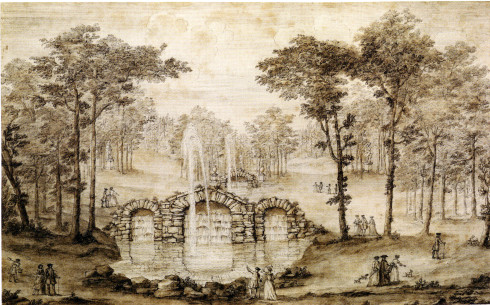I’ve written before about Marble Hill Park, the grounds of Marble Hill House, the beautiful 18th-century Palladian villa near where I live (http://thewhiterajah.blogspot.co.uk/2017/08/a-tale-of-two-houses.html). English Heritage, the quasi-governmental body responsible for houses like this, has plans to re-landscape the Park and I have used these as an example of the problems that can come from dealing with important historical sites within a modern context.
I’m returning to the subject this week because last weekend I had the interesting experience of attending a meeting where members of the public were invited to discuss English Heritage’s ideas. The meeting had been advertised as an opportunity to talk about the plans for the landscaping of the Park, but once we were assembled it was made clear that we were only supposed to discuss the impact of changes on the wildlife habitat and the ecology of the area. Discussion of the concept behind the changes – that parts of the park should be restored to reflect the design of the gardens in 1752 – was not for this meeting. Debate about the legitimacy of this re-creation was to be held over for another day. When I asked if I could come, I was told that this meeting was for historical experts and not for the public.
I can’t help feeling a bit peeved about this. I have always denied being a historical expert, but writing historical novels you can’t help but develop a more detailed understanding of the period that you write about than most non-academics. More importantly, my writing has made me very conscious of the gap between history as historians understand it and the understanding of history of non-specialists. My job, as I see it, is at least partly to communicate about historical events in a way that reaches modern readers. I feel I’m achieving something when I read Amazon reviews like these:
If only my History teacher had read a book like this.
I will admit that I knew very little about Britain’s involvement in India … After reading this book I am now a lot wiser on the subject but don’t feel I was reading a history lesson.
My books also use history to take a sideways look at the world of today. So a book about the British invasion of Argentina to “liberate” the locals from the Spanish had one eye on the invasion of Iraq; a book about colonialism in India was written in the shadow of the Afghan War. History is not about the dead past: its study should show how the world of now is shaped by the world of then.
So how does English Heritage see the best way to present a garden that (as they are all too keen to point out) represents an important moment in English garden development, standing between the formal gardens of the 17th-century and the pastoral naturalism of Capability Brown’s later 18th century work? Sadly, their approach is simply to attempt to recreate an early 18th century garden in the middle of a 21st century municipal park.
The exercise is wrong-headed on so many levels that it is difficult to know where to start.
Let’s begin where English Heritage has begun: with the historical record.
The Survey that isn’t
English Heritage are ever so excited about these gardens, mainly because they have a survey that shows exactly what the grounds looked like in 1752. Their website says:
Research revealed that the c.1752 plan was created to help support Henrietta’s case in a legal dispute over an area of land. This means that – unlike many garden ‘plans’ of the time, which are simply design proposals – it is a survey, showing exactly how the gardens were laid out at the time.

The 1752 plan shown on English Heritage’s website
Only this isn’t a survey at all.
The area that the legal action related to is shown at the bottom right of the map where, ironically, parts are missing. This area may or may not have been properly surveyed. The South East corner of the park, though, isn’t what is getting English Heritage so excited. What they are interested in is the garden area shown at the bottom centre of the map.
The area of the gardens is drawn in a different style from the rest of the map. When the rest of the map is drawn as a plan, with buildings represented by their outlines as seen from directly above, the house and garden are shown with three-dimensional pictures of the buildings marking their approximate locations. This is quite significant, for reasons that date back to the Great Fire of London.
Up until the mid- 17th century, maps were drawn in the way that the house and gardens have been represented here, with houses shown in elevation.

As Peter Whitfield points out, in his excellent London: a life in maps:
… most of the area of the map is filled up with pictures of thousands of little houses, drawn in elevation, and these elevations conflict with and obscure the horizontal scale. For this reason it is not the kind of map that can be used for measurement or to establish boundary lines.
After the fire, accurate maps were essential as there were often no traces on the ground of property boundaries. The result was the commissioning of surveys (properly called) which were presented on the sort of map familiar today. (Note the scale prominently displayed at the bottom of the picture.)

Detail from A Large and Accurate Map of the City of London by John Ogilby and William Morgan (1676)
Significantly, a well-known map of this period shows the important bit (the areas of the city devastated by the fire) in “modern” plan and the surrounding areas in the old pictorial style. (And, again, there is a prominent scale at the bottom left.)

1667 map of the area destroyed by the Great Fire
English Heritage’s “survey” has a scale added at the top – which, oddly, does not exist on an earlier draft plan. More importantly, like the map shown above, it uses two distinct styles – the “modern” style for the legally significant area and the traditional pictorial style for the garden. There is no obvious reason why we should assume that the representation of garden is anything other than a sketch indicating the general line of Henrietta Howard’s layout rather than a precise delineation of the positioning of every individual tree.
A critical reading of the map gives us more reasons for suspecting that we should not take it absolutely at face value. Boundary lines are marked by lines of trees, reflecting the fact that trees may often mark boundaries. However, the map shows perfectly evenly spaced trees for what will be several miles of boundaries over the whole area displayed. Is it credible to assume that all of these boundaries were planted with exactly equidistant trees or is it not more sensible to suppose that the map is simply representing that there is “a line of trees”? To assume that each dot on the map precisely represents the positioning of an actual tree makes no more sense than to assume that the trees marked on a modern OS map are a proper representation of trees on the ground. For anyone with any doubt of the matter, compare the scattered positioning of trees on the map (left) with the satellite photo on the right.


Further doubt about the accuracy of the map is raised by the apparent absence of any tree marker where the famous black walnut (one of London’s specimen trees) stands, and almost certainly stood in 1752. (Recently English heritage have been suggesting that this tree was not planted until the 19th century, but this is certainly not what they have said in the past.)

Does this matter?
It shouldn’t, because any sensible approach to redesigning the gardens would be guided by Henrietta Howard’s overall garden scheme rather than trying to reproduce it tree for tree. English Heritage, though, have drawn up plans which, wherever they can, slavishly reproduce the exact pattern of planting shown in this so-called “survey”. This is very clearly illustrated on their website (http://www.english-heritage.org.uk/visit/places/marble-hill-house/history-and-stories/henrietta-howards-garden/) where you can see the 1752 plan on the left and the 2018 planting plan on the right.

Can we ever recreate the past?
The short answer to the question “Can we ever recreate the past?” is “No.” That’s particularly obvious in the case of this park, where new trees have been planted in areas that were open ground in Henrietta Howard’s time. Modern approaches to arboriculture mean that it would be unacceptable to cut all these down (although English Heritage does intend to remove quite a few). The view that we will see if English Heritage’s plans are ever carried through will be completely different from that seen by Henrietta Howard.
More importantly, the way that we see the world (as it happens, particularly the way that we see gardens) is defined by the social norms of the time that we live in. For Lady Henrietta Howard, a line of trees which have been limbed up (had the lower branches removed) would have been perfectly normal. This was the fashion in 18th century gardens.

Today, trees like this look very strange. We simply do not “see” them in the way that an 18th-century visitor would.
Strangely, when representatives of English Heritage were asked if they intended to limb up trees planted as part of this exercise, they were not sure. This makes no sense at all. To plant trees on an 18th-century plan and then not grow them in the way that an 18th-century gardener would produce something that is neither a 21st-century landscape nor an 18th-century view.
In any case, the social message sent by Henrietta Howard’s garden and the social message sent by the same design today are completely different. Henrietta Howard’s garden, as English Heritage keep stressing, represented an exciting step forward in garden design. For a modern visitor, her garden, if exactly reproduced, would represent a step back by over two centuries. What the bastardised mix of modern park, 18th-century planting patterns ,with modern tree varieties and arboricultural technique will represent is anybody’s guess, but it certainly won’t be a re-creation of the original garden.
In any case, what garden are we recreating? The garden that Henrietta Howard planted? Apparently not, because we’d been told that trees several years old will be used in the planting and it is doubtful that Henrietta Howard’s gardeners had the technological means to move large trees and replant them.
And, in any case, why exactly 1752? English Heritage’s own archaeology has shown patterns of flower beds which are clearly incompatible with the 1752 plan but which, it is assumed, were later built over as the garden was changed. Gardens change all the time. People move flowerbeds, dig ponds, put up statues. Near the house, Henrietta Howard built a folly complete with a spire. It blew down. It is not going to be reinstated, but one could reasonably ask why not. Why are we freezing this garden at one particular moment in time based on the evidence of a single dubious map?
So why are we even attempting this?
Garden History has developed relatively recently as a specialist field within academic history departments. The Garden History Society was only founded in 1966 but by 1995 it became a statutory consultee in relation to planning proposals which affect historic designed landscape.
Garden historians are principally academics. Academics are great people. I spent a while in postgradute study and my wife has a PhD in legal history. There is a lot of truth, though, in the saying that “Academic politics are so vicious because the stakes are so small.” Academics should never be allowed out into the larger world without a keeper.
What seems to have happened here is that garden historians (well represented at the public meeting I attended) have the opportunity to take their theorising out of the library and build an 18th century garden in an actual real park. They are just unbelievably excited. The idea that people might object to their local park being redesigned so that academics can see their theories in real life just does not occur to them. As one garden historian told me, “This is a historical site that just happens to be in a municipal park.” When I suggested that it might be a municipal park that just happens to have a historic house at the centre of it, I was met with blank incomprehension.
A very great deal of money is going to be spent on this project and many people who regularly use the park may well find the changes uncongenial. An area of open land with clear vistas – a rare and splendid thing in London – will have lines of trees put in which in the 18th century were deliberately intended to segment the view. (Again, the changes over time change our perception. The 18th century had far too many open vistas – what Henrietta Howard wanted was the imposition of order.) Dogs may disturb new flower beds and areas of the park may end up closed to dogs. (An initial proposal to keep dogs out of the new garden has been withdrawn; modified proposals may yet slip back in.)
There will be inconvenience and upset but the result may well be an improvement. Or it may not be. A valuable local amenity, preserved from development in the early 20th century when ratepayers bought it as public space, is to be chopped and changed with locals only allowed to tinker at the margins, because academics with no local links have found a new toy.
The true meaning of ‘heritage’: social change and social class
The problem with history is that it keeps changing. The archaeological research already suggests that the pattern of planting in the 18th century altered. Since then, of course, it has changed a great deal more. What, in 2018, is the “heritage” that we want to protect? Is it the gardens of Henrietta Howard? Is it the park after Henrietta Howard when her grotto (a dubious reconstruction of which was built in the 1980s) was buried and lost? Is it the pasture land on which General Jonathan Peel bred racehorses in the mid-19th century? Or is it the municipal park of the early 20th century? There is at least an argument that the historic importance of Marble Hill as an early example of the protection of public open space from private development is as significant to the heritage of modern London as Henrietta Howard’s garden design.

It’s significant that one of the historians at the meeting stressed that Marble Hill is “a historic site” as if this part of London wasn’t all, in one way or another, “historic”. Marble Hill stands on the edge of St Margarets, one of the suburbs that grew up with the development of the metropolitan railway system. (The local station was opened in 1876.) The result is a mix of housing, with splendid Georgian terraces in the traditional “posh” parts near the river and fine Edwardian buildings nearer to the station. The area was targeted by bombers in World War II (heaven only knows why) and there is post-war infill where the bombs fell. The area is a fascinating social and historical mix, of which Marble Hill House is only one part.
Could it possibly be that Marble Hill is “historic” because it was lived in by a countess? Is the favouring of a 18th century garden over 21st century public space about history or about class?
Marble Hill was built at a period when public land was increasingly being brought into private ownership, through a series of parliamentary Inclosure Acts. Marble Hill Park did not enclose any common land (although Lady Howard did go to court to try to restrict public access to a road near her home), but the privatisation of public space was the historical background against which the development of Marble Hill was taking place.
The late 19th and 20th centuries saw this process reverse. The first urban park (in Preston in 1833) was soon followed by the first purpose built publicly owned urban recreational park in England: the Derby Arboretum, which was opened in 1840. The importance of public open space in and around towns was reflected in a series of parliamentary acts, including the Public Health Act of 1875, which enabled local authorities to maintain land for recreation and to raise funds for this purpose. In 1878 the Epping Forest Act preserved the Forest as “an Open Space for the recreation and enjoyment of the public”. The legislative high point of the process of opening private land to the public was probably marked by the Countryside and Rights of Way Act 2000 which gave ‘the right to roam’.
The 21st century has seen a move back to the expansion of private rights over once public land. Increasing amounts of London are now ‘privately owned public spaces’ (pops). Major developments, such as Canary Wharf, Granary Square and More London along the South Bank near Tower Bridge are private land, owned and policed by private companies which can restrict public access. It is not my intention here to join the lively argument being conducted as to whether this is a useful way to improve publicly accessible space without state spending or the effective privatisation of public assets. It is, however, a significant change from the early to mid-20th century notion that the best way to preserve publicly accessible space was to take it into public ownership. To see how a space like Marble Hill has moved from being a private home to a commercial undertaking to land being bought for property development by the Cunards and then being taken into public ownership is to see the history of much open space in this country. Arguably the transfer from the GLC to English Heritage (a quasi-autonomous non-governmental organisation, or quango) demonstrates the shift from straightforward public ownership back towards something that is at least partway to privatisation.
The social history of Marble Hill Park is important to anybody who wants to understand, in its broadest sense, England’s heritage. The park as it is today reflects all of those changes. If English Heritage really cared about heritage and placing England’s history in its cultural and social context, it would be celebrating the park as it is today and explaining the social and political (and, yes, cultural and horticultural) factors that have made it what it is today, rather than privileging one 18th century aristocrat and her vision over everything that has come since.
The books what I write
I write historical novels. Some are set in the wars with France that started not that long after Henrietta Howard died; others are set in the mid-19th century.




My books are intended to be, first and foremost, jolly good reads. (Yes, they appeal to people who enjoy phrases like “a jolly good read”.) I do try, though (quite hard, actually) to give some flavour of what life was like for soldiers in the Napoleonic Wars or civil servants working in India on the brink of revolution. I’m not a professional historian. If a tree gets in the way of my plot, it is unceremoniously planted elsewhere, but I care about history and historicity and I care about how people nowadays see the past. If we could only learn to understand the past better we could, perhaps, gain a better understanding of the present.
Sometimes I think that writers of historical fiction are better at putting people in touch with the past than English Heritage are.
Update
Since this was written, I have been invited to present some of these ideas to the historians’ symposium in June. I am very grateful to English Heritage for this opportunity.


A wonderful feature – hear hear!
Please make contact I need to discuss matters with you urgently.
Tom, I too was at the ‘workshop’, and deeply disappointed at the way Janine was stopped presenting her meticulous research. They were trying to divert us with ecology, butterflies and bluebells and asking us like nursery school children to chop up sheets of pretty pictures. It is what they are glossing over and not telling us that is really worrying.
Have you seen the correspondence in the Times? Today (Wednesday) EH are clearly rattled
Haven’t seen The Times. Will look out for it.
Tammy (the lady with the red jacket) and I were both quite shocked by the way what was billed as a consultation on the landscape proposals turned out to be a general chat about ecology – practically none of which related directly to the proposals about Henrietta Howard’s garden. We both believe that the park needs a lot of work and are sympathetic to some of English Heritage’s problems, but the blind insistence on following that wretched “survey” is not the way to go. Tammy said that she had gone intending to be positive and supportive but the way the whole thing was handled made her very cross.
I do not feel that English Heritage have impressed as professional historians. They speak so positively (“we know exactly” “we have a precise plan”). She says that if she made such unqualified positive comments in her PhD she would have been told to resubmit it.